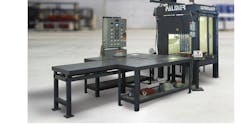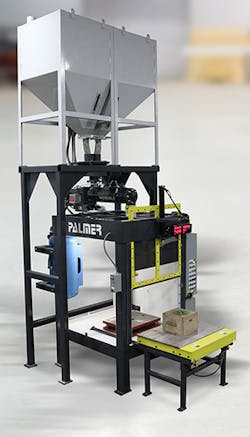Running a jobbing foundry is tough no matter how you look at it. Environmental compliance, personnel issues, government regulations, equipment problems, tooling issues, etc., make for some pretty long days. The type, size, or complexity of work varies every day, always. Jobbing shops are substantially different than production shops in that hundreds or even thousands of parts of any size or type require a completely different approach.
The main advantage of a jobbing shop must be its flexibility and “first time right” capability. All components and processes have to be correct and of high quality the first time.
Many times, coring is the most challenging process. Core boxes may be old and may have been used previously by a number of shops. Usually they aren’t in very good shape or properly vented. The core boxes may be set up for oil sand, shell, or cold-box production, even if the foundry isn’t set up for the particular process.
It’s simple to fill a core box of a simple configuration with some type of no-bake chemically bonded sand on the bench, pack it, strike-off, and wait for it to set up. More complex cores may require blowing, since hand packing of these cores usually results in high labor requirements, at the least, and poor quality or scrap cores at the worst. Boxes set up for cold-box processing require a foundry with cold-box blowing and gassing machine along with ways to deal with the waste stream.
The cores can be purchased from a vendor but this has its own set of problems: cost, delivery time, shipping, receiving, storage, inventory, and quality control. Profitability may be reduced if the purchased cores cost more than internally produced cores. The differences can be significant. An outside vendors schedule may not be as flexible as the foundry’s schedule delaying production. Purchased cores have to be shipped, received, checked for quality, stored, and pulled back out of storage. Freight costs can be significant and packing materials may need to be stored and eventually returned. Extra cores may need to be purchased in anticipation of breakage.
Sometimes there simply isn’t enough time to make the required cores in-house or, the core can be of a certain material or size of material that isn’t available internally at a reasonable cost/delivery time. If the core box is set up for a specific machine and the in-house core room doesn’t have that machine, purchasing the cores is not as much of a choice as a requirement.
The Palmer CM coremaking system can producecores up to about 50 lbs. in about 60 seconds.
Making all cores in-house provides as many cores as needed. It is not uncommon for a production manager to realize that a core or core package is damaged or missing while a mold is being produced. If the shop is equipped with a core machine that can make both simple and blown cores on site, the cores can usually be produced quickly, saving the schedule, keeping costs under control, and adding to the bottom line
It’s widely accepted that a blown core can be better and denser than a hand-packed core, but the greater advantage is consistency. Different operators will make a core different ways and the same operator will make a given core differently from day to day. Blown cores can be the same regardless of the operator.
Traditional cold-box core blowers require a box equipped with machine-specific mounting plates. Then, it takes time to mount the box to the machine. Once mounted, the required number of cores are produced, plus a few extra for breakage. Then, the box is removed, ready for the next box. A normal cycle for a cold-box semi-automatic machine — the magazine swings over the box, clamps, blows, unclamps, swings away, gassing head swings in, clamps, gasses, purges and then swings out of the way — can easily be 30 seconds and up to 60 seconds or more, depending on core size and complexity. Adding in mount/unmount time can mean an average of 4-5 minutes per core
We developed a series of no-bake core blowers and box-handling systems with capacities up to 650 lbs. (295 Kg) to address this specific problem. There are a few items to note when comparing the production cold-box to no-bake chemically bonded cores. First, it’s important that managers realize that it will not be efficient to make one box over and over quickly – this normally results in wasted sand since the set time is made as quick as possible resulting in plugged blow chambers and cores that set up before fully compacted or filled. It’s somewhat counterintuitive, but when making no-bake blown cores, the set time needs to be comparatively long – maybe 3-4 minutes. A number of core boxes can be processed at the same time. This can be accomplished with either a turntable or conveyor next to the machine. One operator stays at the core maker and does nothing but refresh the blow chamber, move boxes into place, blow, and then remove the core box from the machine and get ready for the next core box.
A series of core boxes with a total weight of slightly less than the blow-chamber capacity can be fed to the machine, and blown until the chamber is empty as long as the work time is longer than the required time to blow the succession of boxes. Then the small amount of residual sand can be purged from the chamber. New sand can be run right on top of the residual sand if the work time is sufficient. An operator can move a box in, raise and clamp, blow, lower and unclamp in 30 seconds. The blow chamber can be refilled as the next box is prepared.
The art of this efficient and speedy process is not as much in blowing as it is in manually removing the core from the box. The core is ejected mechanically from most cold-box machines. The operator lifts off the core, or swings in a hoist or core picker for larger parts. With unmounted chemically bonded cores the box needs to be manipulated for quick, safe, and ergonomically correct removal. Obviously, this is case specific but there are many labor saving devices like tool balancers, etc., that make this efficient. The key is that the box is not in the machine – it is external to the machine. While the previous boxes are being stripped, more cores are being blown. Normally, with one operator for the coremaker and one at the removal station, cores up to about 50 lbs. can be produced every 60 seconds. Larger cores will require more time to lay down, remove the box half, remove the core, replace the box half, stand the box up, and return it to the blow machine.
The key to job-shop profitability is flexibility. Palmer CM series of coremakers gives managers a way to make cores of almost any configuration safely and quickly while maintaining repeatable quality.
Jack Palmer, is the president of Palmer Manufacturing & Supply, Inc., a manufacturer of no-bake foundry equipment and systems. Contact him at LinkedIn, or visit www.palmermfg.com
About the Author
Jack Palmer
President
Jack Palmer (1953-2024) was the president of Palmer Manufacturing & Supply Inc., a globally recognized supplier of metalcasting equipment, known for innovative, solution-driven engineering, and high-quality workmanship. They specialize at producing heavy-duty no-bake foundry equipment, including: sand mixers, molding systems, core room equipment, sand reclamation, mold handlers, pumping systems, resin heating systems, sand conditioning, compaction tables, mold and core coating equipment, and complete systems and engineering services.

